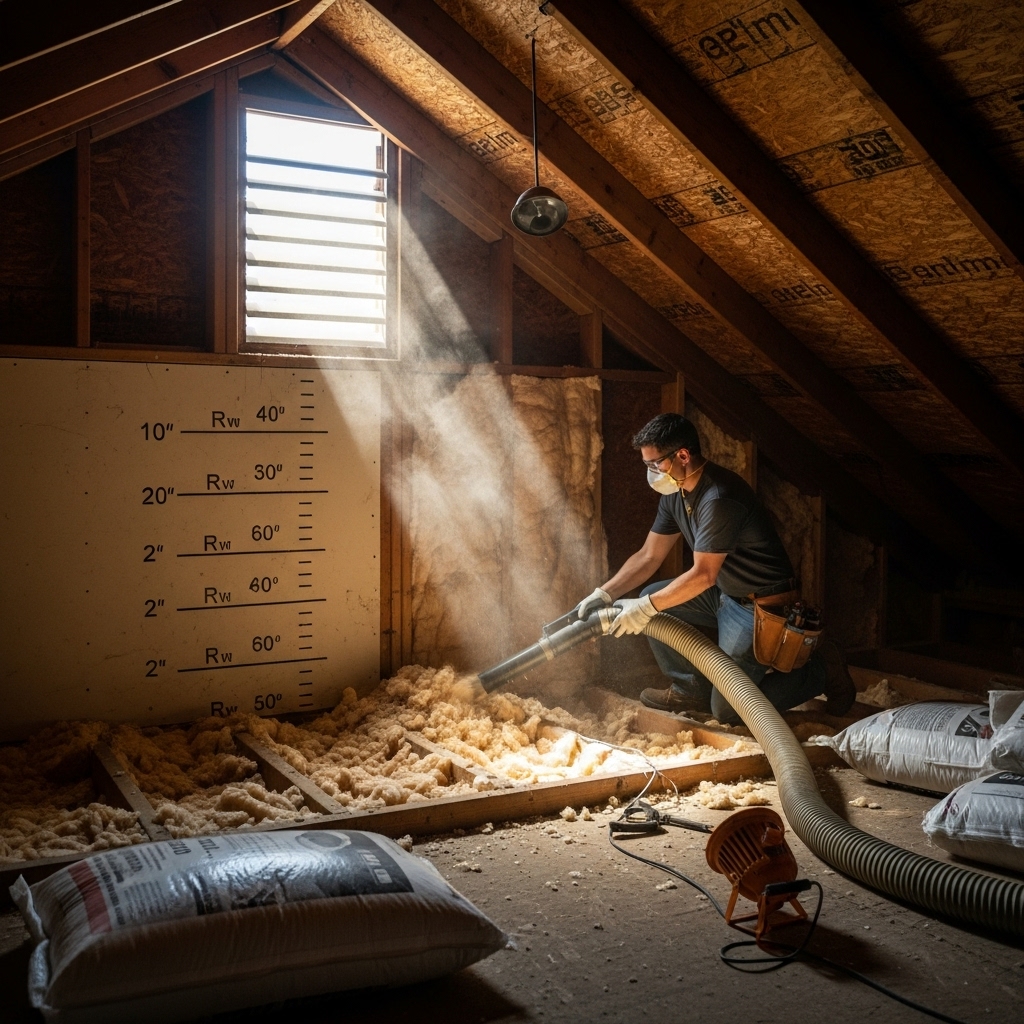When Los Angeles homeowners explore blown-in attic insulation, the conversation often turns to cost—and not just in the abstract. People want to know what truly goes into the figure on a proposal and why quotes can differ for seemingly similar homes. The answer is that “cost” is simply the summary of a dozen small, critical decisions that determine performance: preparation, material type, access, ventilation, and the workmanship that ensures a uniform blanket across the entire attic. Understanding those pieces equips you to compare proposals on more than a single line item and to choose an upgrade that lasts. With a well-executed plan, the right level of attic insulation can transform a house that overheats by afternoon into one that stays calm and comfortable.
Blown-in insulation—whether cellulose or fiberglass—shines in attics because it fills irregular spaces, wraps around obstructions, and achieves consistent coverage that batts struggle to match. In a city with as many architectural eras as Los Angeles, that adaptability is invaluable. Old bungalows with uneven framing, post-war ranches with long spans, and hillside homes with tight corners all benefit from a material that finds the gaps and stitches them closed.
What shapes the cost of a blown-in project
Preparation is the number one factor. Air sealing at penetrations, top plates, and around fixtures ensures the new insulation performs at its rated level. Without this step, convective bypasses carry heat and air through the ceiling plane, undermining even a deep blanket. Proper preparation also includes installing eave baffles to protect airflow from soffit to ridge and prevent wind from thinning insulation at the perimeter, as well as insulating and gasketing the attic hatch so it doesn’t become a thermal weak spot.
The choice of material matters, too, but not in the simplistic “which is cheaper” sense. Blown-in cellulose and blown-in fiberglass both achieve excellent results when installed to the correct depth and density. They differ in characteristics that might matter to you: cellulose’s cohesive, dense coverage and acoustic benefits; fiberglass’s light, airy blanket and resilience. Your priorities—noise reduction, green content, handling—help determine which material belongs in your attic. The resulting scope, including target R-value and depth, is part of what you see summarized as “cost.”
Access is rarely discussed in ads, but it is critical in the field. A tall, roomy attic allows efficient work and easy hose management. Shallow pitches, tight hatches, and complex framing slow progress and demand more careful setup to protect your living spaces below. If your attic doubles as storage, the plan may include building raised platforms above the insulation line so you can keep access without crushing the new material. Each of these realities must be accounted for, and they influence the investment required.
Existing conditions: remove, top up, or start fresh
Los Angeles attics come in every condition. Some have a light layer of existing insulation that is clean and evenly distributed; topping up with blown-in material is straightforward and efficient. Others show signs of patching, contamination, or settling that suggest removal and a clean start will deliver a better outcome. Removal involves containment, extraction, and cleanup to prepare a stable base for the new blanket. The decision between topping up and removing is not cosmetic—it affects performance, schedule, and scope.
Fixtures and penetrations also complicate the picture. Recessed lights not rated for insulation contact require specific detailing or replacement. Bath fans must vent outdoors, not into the attic space. Chimney chases and skylight wells demand non-combustible clearances and thoughtful transitions from vertical to horizontal planes. These details take time and skill, and while they may be tucked into a line or two on a proposal, they are central to the comfort and safety of your home.
Uniform coverage: the hallmark of a quality job
What separates an excellent blown-in project from an average one is uniformity. Depth markers posted throughout the attic give installers targets and homeowners peace of mind. Even coverage across the main field, around HVAC platforms, and into the edges near the eaves confirms that the rated R-value exists everywhere it should. A few thin spots can create hot or cold patches that you’ll notice immediately in the rooms below. The best crews move systematically and check their work as they go, ensuring the blanket is truly continuous.
Another underrated element is the attic hatch. It’s an easy place to lose performance if it’s left uninsulated or poorly sealed. A tight, insulated cover aligned with the surrounding R-value makes the difference between a smooth thermal boundary and a glaring weak link. This simple detail often separates a job that looks good on paper from one that feels good in daily life.
Ventilation: the partner to blown-in performance
Ventilation allows the attic to shed heat and control moisture, making it the silent partner to your blown-in insulation. If soffit vents are blocked by old materials or debris, or if ridge ventilation is inadequate, the plan should include remedies. Without steady airflow, even a deep layer of insulation can be stressed by heat buildup, especially under darker roofs. Restoring ventilation ensures that the new blanket performs as promised through August heat and winter cool-downs alike.
In Los Angeles’s dry climate, moisture issues are less common than in colder, wetter regions, but they can still arise around bath fans, roof leaks, or coastal fog intrusions. Addressing these before or during the insulation project preserves the longevity of both the insulation and the roof assembly.
How to compare proposals fairly
When you receive multiple quotes for blown-in attic insulation, read beyond the headline number. Look for clear notes on air sealing, eave baffles, hatch insulation, target R-value, and depth markers. Ask about how the crew will protect your home during installation and how they will handle storage or delicate areas. Clarify whether removal is included, if needed, and how ventilation will be verified. These are the signals of a comprehensive plan rather than a bare-minimum bid.
It’s also reasonable to ask for photos of similar attics after completion. You’ll quickly spot the difference between sparse coverage and the kind of uniform, billowy blanket you want to see in your own home. A well-documented scope helps you compare apples to apples and feel confident you’re choosing the job that will perform for years.
What to expect on installation day
Most blown-in projects are efficient. Crews protect the areas below the hatch, move systematically through air sealing, set baffles, and then begin the blow. Hoses extend to the far corners first so that edges and tricky spots are addressed while the team is fresh. As the attic fills, installers check depth at markers, ease the material into tight areas, and step back to verify that the blanket is continuous. When storage platforms are part of the plan, these are built before the blow so that the insulation can remain undisturbed.
Once the work is finished, the change is immediate. Rooms feel less volatile as the day warms, and evenings hold onto comfort longer. Your HVAC system cycles more calmly, which you’ll notice in both sound and feel. It’s the kind of upgrade that quietly pays you back every single day.
Frequently asked questions
Is cellulose or fiberglass better for blown-in projects?
Both are excellent when installed to spec. Cellulose offers cohesive coverage and acoustic benefits, while fiberglass delivers a light, resilient blanket. The best choice depends on your attic’s layout, your priorities, and the details of your roof assembly.
Do I need to remove old insulation first?
Not always. If the existing layer is clean, dry, and even, topping up is efficient and effective. If it’s contaminated, patchy, or causing ventilation problems, removal followed by a fresh, uniform blow will likely yield better results.
How important is air sealing?
It’s foundational. Air sealing prevents convective bypasses that can undermine even a deep insulation layer. Sealing first lets the new blanket reach its rated performance, making your rooms feel calmer and more consistent.
What about the attic hatch?
Insulate and seal it. An uninsulated hatch can function like a hole in your thermal blanket. A tight, insulated cover aligned with the surrounding R-value keeps the boundary intact and performance steady.
Will blown-in insulation help with noise?
Yes. The added mass and coverage often reduce exterior noise and soften sound transmission through ceilings. Many homeowners notice the quiet as much as the thermal improvement.
How long does installation usually take?
Most projects are completed in a day, sometimes two, depending on preparation, access, and whether removal or platform building is included. A detailed scope will set realistic expectations for your specific attic.
Take the next step with confidence
If you’re ready to turn a hot, unpredictable home into a steady, comfortable one, start with a thorough attic evaluation and a clear plan. A well-executed upgrade in attic insulation tailored to Los Angeles conditions will deliver comfort you can feel every day. Reach out to a trusted local team to review your attic, explain options, and schedule a transformation that lasts.

